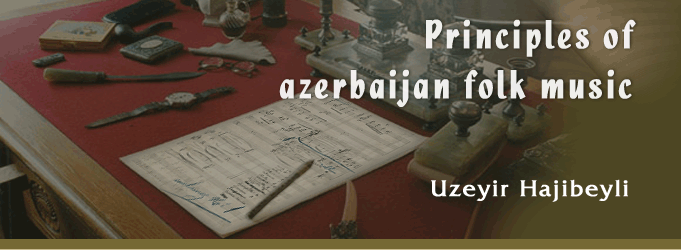

INTRODUCTION
Special study is required for the following:
- to examine the main principles of Azerbaijani folk music;
- scientific and theoretical analysis of the laws constructing Azerbaijan modes; and rules producing sensible melodies based on these laws.
These main principles base on the following factors:I. Sound system.
П. Ways of tetrachords combining .
III. Rules of constructing scales of Azerbaijani modes.
IV. Rules of composing Azerbaijani modes
Without a special investigation of the above principles, it would be hard for a musicologist:
- to make correct and scientific conclusions while studying Azerbaijani folk music;
- to evaluate the artistic virtue of folk music.
If a composer wants to create in the language understandable for people, if he wants to satisfy the high demands of the audience, it would be impossible without fundamental knowledge of rules to compose music in folk modes.Let us give 11 examples of music sharing the same theme, but with different cadences.
It is required to define modal bases of the given examples:
In the first three bars (see examples 1, 2, 3, 4, 5, 6 and 7) one and the same melody is repeated. First three bars are the same, but the last two bars have different cadences. And these cadences define the belonging of the above examples to one or other mode.
In examples 8, 9, 10, and 11 the first two bars are repeated but the last three bars differ by modal signs though the last three examples end with one and the same tone — re.
The first example starts with the section (sho’be) of the mode "Segah" called "Mubarriga" (the first three bars) and ends with the mode called "Rast" (the last two bars).
Examples 2, 3, 4, 5, 6 and 7 start as the first one, with the same mode of "Segah” but end in different ways:
– 2 – with the mode "Shur";
– 3 – with the mode "Segah";
– 4 – with the section of "Shur" called "Zaminkhara";
– 5 – with the section of "Segah" called "Shikasteyi-Phars";
– 6 – with that of "Shur called "Bayati-Kurd";
– 7 – is an example of modulation from the mode "Segah" to the mode "Chargah".Examples 8, 9, 10 and 11 differ distinctly from the above:
– example 8 refers to the mode "Bayati-Shiraz";
– example 9 – to "Shushtar";
– example 10 – to "Charge"; and
– example 11 – to "Humayun".'"Rast", "Shur", "Segah", "Shushtar", "Chargah", "Bayati-Shiraz" and "Humayun" are essential seven Azerbaijan modes.
The most popular of them are "Shur" and "Segah". The great majority of Azerbaijani songs, dances, tunes, and other musical forms are composed in these two modes. "Rast", "Shusthar", "Chargah" and "Bayati-Shiraz" are popular, as well. "Humayun" is less popular.
Aesthetical and psychological features of them are the following:
- "Rast" evokes the feelings of courage and fortitude;
- "Shur" – merry lyrical mood;
- "Segah" – love;
- "Shushtar" – sorrow;
- "Chargah" – agitation and passion;
- "Bayati-Shiraz" – melancholy;
- "Humayun" – deep or even deeper sadness, as compared to "Shushtar".In addition to the listed essential modes there are sufficiently popular subsidiary modes and no less popular sub-sections. They are the following:
- "Shahnaz";
- "Saranj";
- "Bayati-Kurd";
- "Hijaz";
- "Gatar"; and many others, 70 in all.Musicologists determine total modes’ number in the music of many nations differed in degree of their musical culture, such as Egyptians, Chinese, Greeks, Arabs, and Hindus as 84 in all, independently on used calculation system.
7 essential Azerbaijani modes constructed from each tone of 12-step chromatic gamma give the same figure – 84.










